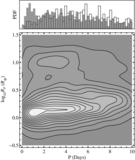From Hot Jupiters to Super-Earths via Roche Lobe Overflow
Abstract
Through tidal dissipation in a slowly spinning host star, the orbits of many hot Jupiters may decay down to the Roche limit. We expect that the ensuing mass transfer will be stable in most cases. Using detailed numerical calculations, we find that this evolution is quite rapid, potentially leading to the complete removal of the gaseous envelope in a few gigayears, and leaving behind an exposed rocky core (a "hot super-Earth"). Final orbital periods are quite sensitive to the details of the planet's mass-radius relation and to the effects of irradiation and photo-evaporation, but could be as short as a few hours or as long as several days. Our scenario predicts the existence of planets with intermediate masses ("hot Neptunes") that should be found precisely at their Roche limit and in the process of losing mass through Roche lobe overflow. The observed excess of small single-planet candidate systems observed by Kepler may also be the result of this process. If so, the properties of their host stars should track those of the hot Jupiters. Moreover, the number of systems that produced hot Jupiters could be two to three times larger than one would infer from contemporary observations.
- Publication:
-
The Astrophysical Journal
- Pub Date:
- September 2014
- DOI:
- 10.1088/2041-8205/793/1/L3
- arXiv:
- arXiv:1408.3635
- Bibcode:
- 2014ApJ...793L...3V
- Keywords:
-
- planetary systems;
- planets and satellites: gaseous planets;
- planet-star interactions;
- stars: evolution;
- stars: general;
- Astrophysics - Earth and Planetary Astrophysics;
- Astrophysics - Solar and Stellar Astrophysics
- E-Print:
- 6 pages, 4 Figures. Accepted by ApJL
